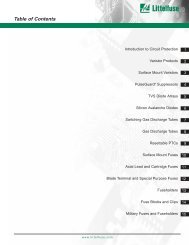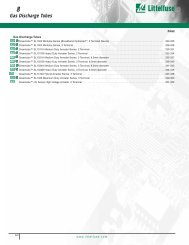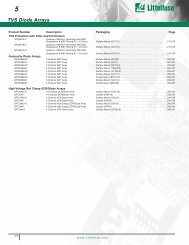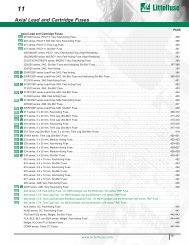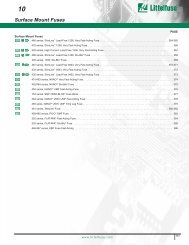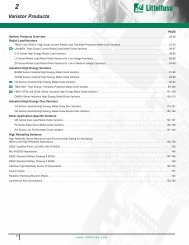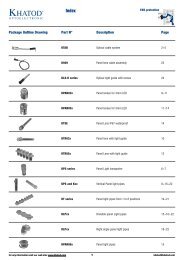ALUMINUM ELECTROLYTIC CAPACITORS
ALUMINUM ELECTROLYTIC CAPACITORS
ALUMINUM ELECTROLYTIC CAPACITORS
You also want an ePaper? Increase the reach of your titles
YUMPU automatically turns print PDFs into web optimized ePapers that Google loves.
PRECAUTIONS AND GUIDELINES (Conductive Polymer)<br />
The NPCAP TM is a Conductive Polymer Solid Aluminum Capacitor that uses highly conductive polymer electrolytic material.<br />
Please read the following in order to get the most out of your NPCAP TM capacitor.<br />
For aluminum electrolytic capacitors, please refer to PRECAUTIONS AND GUIDELINES.<br />
Designing Device Cir cuits<br />
Types of Circuits Where NPCAP<br />
The leakage current in conductive polymer solid aluminum capacitors<br />
(hereafter called capacitors) may vary depending on<br />
thermal stresses during soldering. Avoid the use of capacitors<br />
in the following types of circuits:<br />
a) High-impedance circuits that are to sustain voltages.<br />
b) Coupling circuits<br />
c) Time constant circuits<br />
Because the capacitance varies depending on the environment<br />
the capacitors are used in, there is a possibility that the<br />
capacitor can affect a time constant circuit where sensitivity<br />
to variation in capacitance is required.<br />
d) Other circuits that are signifi cantly affected by leakage current<br />
TM 1<br />
Capacitors are Not to be Used<br />
2 Circuit Design<br />
Verify the following before designing the circuit:<br />
a) The electrical characteristics of the capacitor will vary depending<br />
on differences in temperature and frequency. Only<br />
design your after verifying the scope of these factors.<br />
b) When connecting two or more capacitors in parallel, ensure<br />
that the design takes current balancing into account.<br />
c) When two or more capacitors are connected in series, variability<br />
in applied voltage may cause over-voltage conditions.<br />
Contact Nippon Chemi-Con before using capacitors connected<br />
in series.<br />
3 Use in High Reliable and Critical Applications<br />
Consult with Nippon Chemi-Con before using these capacitors<br />
in applications involving human life: Aviation/space equipment,<br />
Nuclear power equipment, Medical equipment and Automotive<br />
equipment, or in applications where capacitor failure could have<br />
a major impact.<br />
The NPCAPTM 4 Polarity<br />
is a polarized solid aluminum electrolytic capacitor.<br />
Do not apply either reverse voltages or AC voltages to the<br />
polarized capacitors, using reversed polarity may cause a short<br />
circuit. Refer to the catalog, product specifi cations or capacitor<br />
body to confi rm the polarity prior to use.<br />
5 Operating Voltage<br />
Do not apply DC voltages exceeding the full rated voltage. The<br />
peak voltage of superimposed AC voltages (ripple voltages)<br />
on DC voltages must not exceed the full rated voltage. While<br />
there are specifi cations for surge voltages exceeding the rated<br />
voltage, usage conditions apply, and continued operation for<br />
extended periods of time under such conditions cannot be<br />
guaranteed.<br />
6 Ripple Current<br />
Do not apply currents in excess of the rated ripple current. The<br />
superimposition of a large ripple current increases the rate of<br />
heating within the capacitor. This may reduce the service life of<br />
the capacitor or damage the capacitor.<br />
7 Operating Temperature<br />
Do not use the capacitor at high temperatures (temperatures<br />
exceeding the maximum temperature for the capacitor category).<br />
Use of the capacitor outside of the maximum temperature for<br />
the capacitor category may decrease the service life of the capacitor.<br />
(1/4)<br />
Do not use the NPCAPTM 8 Charging and Discharging the Capacitor<br />
capacitor in circuits where the capacitor<br />
is repetitively charged and discharged rapidly. Repetitively<br />
charging and discharging the capacitor rapidly may reduce the<br />
capacitance or may cause damage due to internal heating. Use<br />
of a protective circuit to ensure reliability is recommended when<br />
rush currents exceed 20A.<br />
Based on the JIS C 5003 Standard, the failure rate for<br />
NPCAPTM capacitors (with a 60% reliability standard) is as follows:<br />
0.5%/1,000 hours (applied rated voltage<br />
at category temperature)<br />
a) Failure Modes<br />
The main cause of failure is thermal stress caused by the<br />
solder refl ow process or thermal use environment, along<br />
with electrical and mechanical stresses. The most common<br />
capacitor failure mode is the short circuit mode, where the<br />
following phenomenon may occur after shorting:<br />
(1) If the pass-through current when the product is shorted<br />
is 1A or less, then the product becomes heated, but no effects<br />
are visible, even when the current is continuously carried.<br />
However, larger currents may cause substantial internal<br />
heating that causes the rubber seal to separate from the<br />
case, causing the release of gas.<br />
(2) Some fl ammable materials are used in the capacitor. If<br />
an extremely large electric current fl ows through the capacitor<br />
after shorting, the shorted part may spark, and in a worstcase<br />
scenario, may ignite. Ensure safety by fully considering<br />
the design issues described below when using this capacitor<br />
in equipment where safety is a priority.<br />
• Increase safety by using in conjunction with a protective<br />
circuit or protective equipment.<br />
• Install measures such as redundant circuits so that the<br />
failure of a part of the equipment will not cause unstable<br />
operation.<br />
b) Service Life<br />
NPCAPTM 9 Failures and Service Life<br />
uses rubber as the sealing material, so the service<br />
life depends on the thermal integrity of this rubber. Consequently,<br />
it is recommended to use the capacitor at a lower<br />
temperature than the maximum temperature for the capacitor<br />
category.<br />
10 Capacitor Insulation<br />
Ensure electrical insulation between the capacitor case, negative<br />
electrode, positive electrode and circuit pattern.<br />
11 Capacitor Usage Environment<br />
Do not use/expose capacitors to the following conditions.<br />
a) Oil, water, salty water, take care to avoid storage in damp<br />
locations.<br />
b) Direct sunlight<br />
c) Toxic gases such as hydrogen, sulfi de, sulfurous acids, nitrous<br />
acids, chlorine and chlorine compounds, bromine and<br />
bromine compounds, ammonia, etc.<br />
d) Ozone, ultraviolet rays and radiation.<br />
e) Severe vibration or mechanical shock conditions beyond the<br />
limits advised in the product specifi cation section of the catalog.<br />
CAT. No. E1001H




